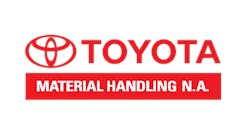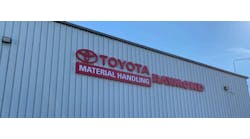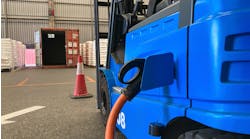OSHA is getting tougher on lift truck safety, so it’s time for material handling managers to revisit operator education. Here’s how vehicle manufacturers can help.
An employee at a Medley, Fla., manufacturing plant was checking oil in a lift truck. While standing outside of the vehicle, he started the engine. The lift truck rolled over him, killing him.
An OSHA investigation concluded that Trusscorp International, a manufacturer of roof trusses, willfully violated OSHA standard 1910.178: Powered Industrial Trucks by failing to educate employees about safe operation of lift trucks. Because an inspection revealed that the parking brake was faulty, additional violations included failure to inspect the vehicle before operating it and failure to remove the defective lift truck from service.
OSHA fined the company $92,650. It’s incidents like this that have led OSHA to crack down on lift truck safety violations in recent years. “Compliance visits and citations for 1910.178 have gone up since 2001,” says Calvin Tanck, vice president of marketing at Hyster Co. (Greenville, N.C.). “OSHA is more alert and doing more investigating, so it is more critical to recognize these standards,” he says.
Ron Brewer, manager of operator training at Crown Equipment Corp. (New Bremen, Ohio), agrees. “We are seeing a resurgence of OHSA’s focus on this standard,” he says.
Last year, OSHA announced a stronger national focus on powered industrial trucks. It is also drilling down to specific regions of the U.S. In 2007, the government agency established “regional emphasis programs” for powered industrial truck safety in four out of 10 total regions, according to OSHA education firm Complete Safety Concepts (Milwaukee). Arizona, California, Hawaii, Nevada, Connecticut, Massachusetts, Maine, New Hampshire, Rhode Island, Vermont, Illinois, Indiana, Michigan, Minnesota, Ohio, Wisconsin, Iowa, Kansas, Missouri and Nebraska were all tagged as states OSHA is watching for lift truck violations.
“The OSHA FY 2007 strategic management plan is targeting a national reduction in fatalities caused by powered industrial vehicles (PIV),” reported OSHA in a regional emphasis alert statement. “The reason for the national and local emphasis on powered industrial vehicles is the need to reduce the number of fatalities caused by PIVs. Industrial vehicle use is an area where there are a high number of fatalities, but for which there had been no strategic national focus until fiscal year 2007.”
OSHA is paying more attention to 1910.178 because it continues to be one of the more common violations. Every year, OSHA releases a top-10 list of the most commonly penalized standards. In 2007, the standard came in sixth place. The section under the Powered Industrial Trucks standard most often cited by OSHA was 1910.178 (L) (l) (i)—failure to ensure each powered industrial truck operator is competent to operate a powered industrial truck safely. Failure to certify operators—1910.178 (L) (6)—was number three on the list, while failure to evaluate operators once every three years—1910.178 (L) (4) (iii)—was fourth.
In 2006, there were 3,080 violations of standard 1910.178. The following year, there were 3,478 citations, and lack of proper operator education accounted for more than 1,200 of them. OSHA estimates that lift truck accidents account for 100 deaths and 95,000 injuries each year. The government agency reports that 25% of these accidents result from a lack of operator education. Now more than ever, it’s time to revisit lift truck operator education. Fortunately, plenty of help is available. Lift truck manufacturers and their dealers are doing their part to help manufacturers and distributors comply with the regulations and keep their workers safe and productive. Smart material handling managers are taking advantage of the wide range of tools available.
Creative Learning
To make operator education easier for their customers, lift truck manufacturers are offering educational material in unique, digital formats.
Hyster just released its “Productivity in Motion” operator education program in DVD. Each DVD has a menu that allows users to view an educational presentation or download an instructor’s guide, test questions, operator’s manual, course completion certificates and authorization wallet cards. Hyster offers English, Spanish and French versions of the DVDs for Class I-V lift trucks.
Supporting documents now available electronically—right on the DVD— include instructor’s guides, questions, operator’s manuals, certificates and authorization cards. “The DVD format allows for on-demand printing of an unlimited number of operator training support documents and interactive text fields on certificates and authorization cards,” says Tanck. Previously, end users had to order hard copies of supporting documents and wait for them to come in the mail, but now, they can simply download them from the DVD.
“Our program describes lift truck fundamentals and analyzes operating principles such as load center, stability and correct stacking,” according to Hyster. “The program also focuses on pedestrian safety, awareness of hazardous situations and accident preparedness. These topics empower your operators with the skills and understanding required for proficient and professional lift truck operations, which can result in increased productivity and a positive impact on your bottom line.”
Yale Materials Handling Corp. (Greenville, N.C.) also offers its “The Key to Productivity” operator education DVD in English, Spanish and French. Yale suggests that customers use the DVD along with classroom and application education.
As a complement to its educational DVD, Yale launched an online, lifttruck driving game on its Web site at www.northamerica.yale.com. “It’s a fun, interactive game with a serious message,” says Allen Haggar, manager of advertising and promotions at Yale. The game is also a way to get the word out about a free safety poster Yale offers. The educational poster provides an overview of safety ‘dos and don’ts’ and features lift truck safety tips.
“The Yale lift truck safety tips poster program has been very well received, with more than 8,000 posters shipped during the past four months in North America alone,” says Haggar. “The Yale poster program started in North America and Asia Pacific. Our Latin American marketing group is translating them into Spanish.”
Mitsubishi Caterpillar Forklift America Inc. (Houston) also offers operator education in English and Spanish. The company’s seven-part education program addresses lift truck fundamentals, pre-operational instruction, safety guidelines, load-handling techniques, fueling gasoline, diesel and liquid propane lift trucks and battery charging and recharging.
The “Safety on the Move” operator education program from Raymond Corporation (Greene, N.Y.) is a combination of classroom and hands-on learning that can be conducted independently by end users or with the help of a lift truck dealer. The Raymond education kit includes an instructor’s manual, safety and model-specific videos, student work-books, a PowerPoint presentation, safety posters, certificates, safety reminder cards and operator’s manuals.
One unique feature of Raymond’s program is the digitizing of the media portions, allowing for “distributed learning.” “Distributed learning is a method for broadcasting education to different locations,” says Mike Angelini, manager of field training services at Raymond. He gives an example: “One customer asked us to digitize all the video-tape portions of the program into an MP3 file to put on its server, so the material would be consistent across all of their locations.” That way, each company location could go to its corporate server and download the most up-todate safety materials.
This type of learning is becoming more prevalent as companies grow, according to Angelini. “If a company has 100 locations, they would need 100 copies of training media,” he says. “Distributed learning is one way to make sure all locations have the same safety information available from a central server, and there is no need to have 100 tapes to track.”
Continuous Education Raymond is also currently working on offering lift truck operator refresher education. OSHA requires companies to recertify their lift truck operators at least once every three years.
Similarly, Clark Material Handling Co. (Lexington, Ky.) focuses on refresher education by encouraging its dealers to be proactive with their customers and educate them often, says David Nicolette, technical trainer. “We encourage our dealers to become partners with employers in their material handling education and visit customer sites,” he says. “Customers should do refresher training at least two or three times a year.”
Nicolette explains that the OSHA regulation requires site-specific, as well as truck-specific, education. “The requirement states that employers need to refresh training any time a new truck is introduced and any time the operating environment changes,” he says. Nicolette explains that a facility environment can change almost daily; even seasonal changes outside can alter operating conditions inside.
Along with continual sit-down rider operator education, Clark also offers DVDs and educational booklets for stand-up riders and pallet trucks. “The definition [from OSHA] of a powered industrial truck is any mobile, powerdriven vehicle that carries, pushes, pulls, lifts, stacks or tiers material.”
Train-the-Trainer
In addition to operator education, plenty of lift truck manufacturers offer “train-the-trainer” programs. Toyota Material Handling USA Inc. (TMHU, Irvine, Calif.) has two types of education programs specifically designed for instructors.
The first is a three-day course that focuses on the basics and targets those who are new to teaching operator safety. Most of TMHU’s safety education takes place at the company’s training center in Columbus, Ind.
The second program is a new workshop that the company just started offering this year. “Once every quarter, we will bring experienced trainers together in Columbus, Ind., for two days to share ideas about what works and what doesn’t,” says Pat Huebel, national training and customer center operations manager at TMHU. “The focus is to make them better trainers.”
Nissan Forklift Corp. (Marengo, Ill.) also offers train-the-trainer programs, but the company is doing something extra to help its customers pay for it. “We work closely with local junior colleges,” says Wayne Wilde, director of training and technical publications at Nissan Forklift. “They can usually help get small-business grants for education on safety and environmental issues. We provide the training to the companies, which can then apply for grant money. This can save our customers 50% to 60% of the cost of coming to an operator train the- trainer course.”
Operator education classes are held at Nissan Forklift’s factory training center in Marengo, Ill. Videos and CDs are available, and Wilde says the company is getting ready to switch to DVD pedesformat. Education programs for Class I, IV and V will be available on DVD by mid-March, according to Wilde.
Educate the Supervisor
Like other lift truck manufacturers, Crown offers model-specific operator education, pedestrian safety and train-the-trainer programs. However, Crown also offers a third type of education that is often the most overlooked component of lift truck safety education, according to Brewer.
“Supervisors are one of the most overlooked, yet probably most influential, people directly involved in lift truck safety,” says Brewer. “Trainers may only have one day with operators,” he says. “Supervisors take over from there. A knowledgeable supervisor can help operators further develop and retain the safety skills learned in initial training on an ongoing basis.”
That was the motivation behind Crown’s release of DP LeadSafe education for supervisors. “DP” stands for “demonstrated performance” and refers to hands-on learning. “Many supervisors don’t have the training or experience to understand what safe and proper operation of lift trucks looks like,” says Brewer.
LeadSafe teaches supervisors to identify proper and improper lift truck operation, give feedback to lift truck operators, perform and understand the pre-use inspection process, understand OSHA requirements and identify proper and improper pedes trian behavior, says Crown. As they view videos showing common mistakes, supervisors identify the errors, explain the consequences and discuss the proper behavior.
Brewer says Crown started offering LeadSafe six months ago because customers asked for it. “Customers reported that efforts to educate and expand supervisors’ focus on safety not only resulted in improved safety but also improved productivity and reduced product, facilities and equipment damage. Their effort to improve safety made them more profitable.” By the end of April, all of Crown’s regional training facilities will offer LeadSafe.
TMHU also strongly stresses supervisor education. “Far too often, supervisors don’t know what operators should be doing. We strongly encourage supervisors to get involved in training,” says Huebel.
One way Huebel says supervisors can get involved in ongoing operator education is by holding a lift truck rodeo. “We tell our trainers about this. Some of our end users are doing it,” he says. Lift truck rodeos pit operators against each other in a fun skills competition. Participants get points for using proper driving techniques and penalized for mistakes.
Though not technically OSHAgrade education, a lift truck rodeo can be “a fun way to get the point across to operators that safety is number one,” says Huebel.
No matter how material handling managers choose to educate their lift truck operators, one thing is certain: Practicing proper lift truck safety techniques and continually educating operators will avoid OSHA’s wrath. It will also bring more productivity, reduce product damage and boost the bottom line. It may even save lives.



